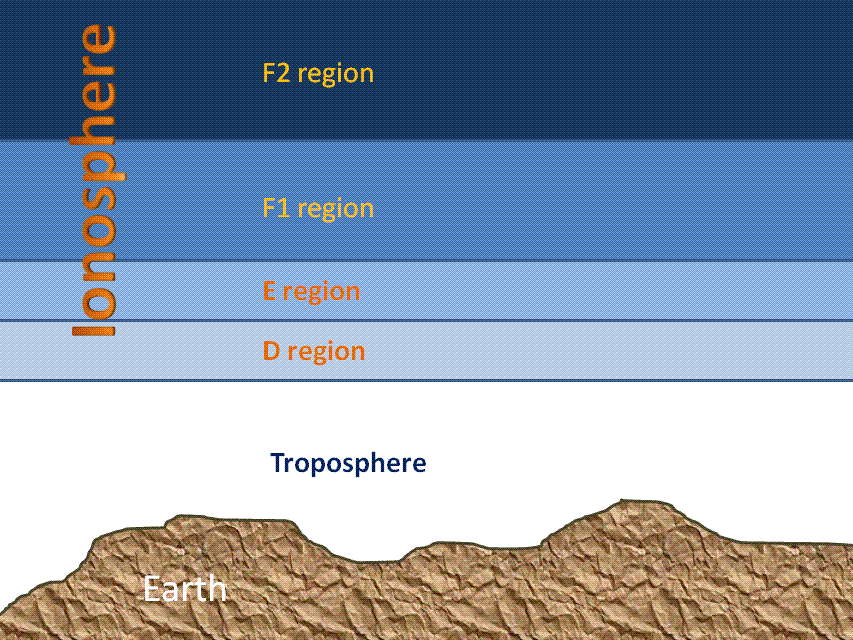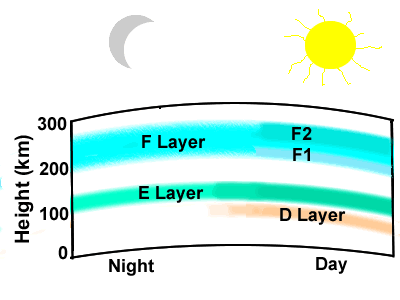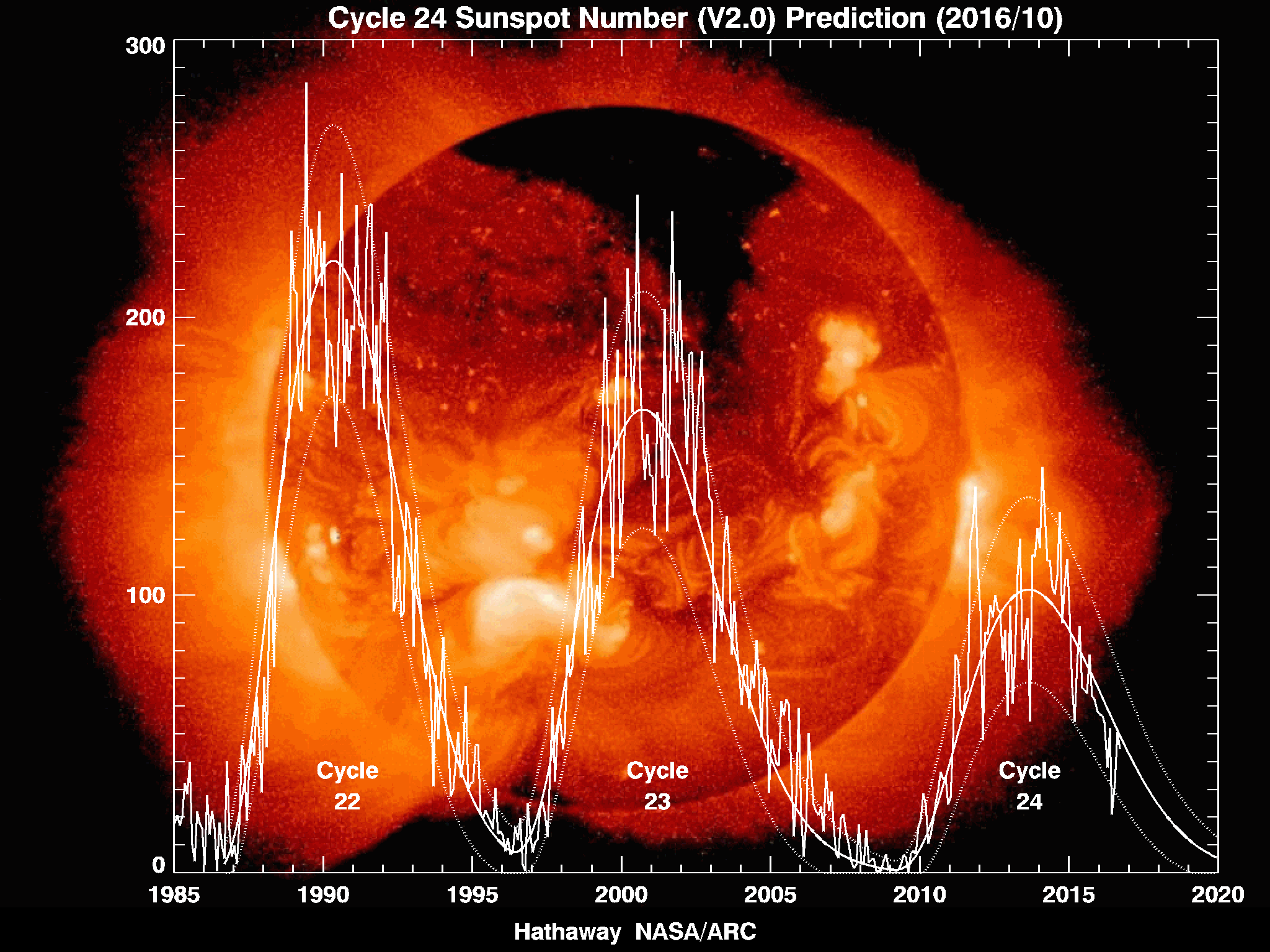
| The ionosphere is the upper part of the atmosphere, extending from about 50 km to 2000 km above the Earth's surface. The part we are interested in for EM transmission is the lower 500 kilometers. In the ionosphere, radiation from the sun (primarily X-rays, ultraviolet and particles) bombard gas molecules and cause them to release electrons. These are called "free electrons" and they are negatively charged. The molecules that lose the electrons become postively charged. The name for charged molecules or atoms is "ions" and these positive ions are what the ionosphere is named after. The free electrons and ions cause HF radiation that is moving upward to bend back toward the earth, an effect called refraction. This bending allows the signals to travel back down to the surface at ranges well over the horizon, giving HF radiation its unique long range characteristics. When radiation from the sun is no longer present during nighttime, many of the electrons join back with the ions, but some remain free throughout the night. An important parameter for EM propagation is the amount of free electrons that are present; this is called the "electron density". The higher the electron density, the more HF radiation is bent toward the surface. |  |
There are three important layers in the ionosphere summarized in the table below.
Table 1. Layers of the Ionosphere
| Layer |
Approximate Elevation
|
Importance
|
When Present
|
|
F
|
140 km - 400 km
|
Main "reflection" region
|
Always - stronger during daytime
|
|
E
|
90 km - 140 km
|
Lower frequency "reflection" region
|
Always - but very weak at night
|
|
D
|
50 km - 90 km
|
Main absorption region
|
Daytime only
|
F layer
The F layer is the highest significant layer in the ionosphere and the central part has has the greatest electron density in the earth's atmosphere. This is the main region where HF radiation from below is bent back down. We use the term "reflection" in the table because the bending is like a reflection. Technically, this bending process is called refraction, but we can think of it as a reflection from the F layer. During the day the F layer separates into two layers, called F1 and F2. The F2 is the stronger and more important layer.
E layer
This central part of this layer represent contains another peak or maximum value in electron density. However there are fewer electrons in the E layer compared to the F layer and therefore it is not usually as important for bending of HF radiation as the F layer. Some lower HF frequencies, particularly during the day, will be "reflected" by this layer, which, because it is lower then the F layer, may result in reduced range. This layer is highly variable in space and time. Sometimes disturbances will cause abnormal reflections in parts of the E layer. When this occurs a "Sporadic E" layer is said to be present.
D Layer
This layer contains some free electrons and ions, but also many more normal (or neutral meaning uncharged) molecules and atoms. When radiation interacts with an electron it cause the electron to move. If the electron runs into a neutral molecule or atom, it is absorbed and so is the energy from the radiation. Therefore the primary effect of this layer is to absorb radiation. This is bad for transmissions because when the radiation is absorbed, the signal is lost. The lower the frequency of transmission the more the electron moves and the more likely it is to be absorbed. Therefore the lower the frequency the more the D layer absorbs the transmission energy.

Figure 1. Ionospheric layers. At night the E layer and F layer are present. During the day, a D layer forms and the E and F layers become much stronger. Often during the day the F layer will differentiate into F1 and F2 layers.
"Diurnal" refers to day-night cycle that occurs every 24 hours on Earth. The sun has a huge effect on the characteristics of the ionosphere (Figure 1). During the daylight hours, the electron densities in the E and F layers are about 100 times larger than at night. The D layer completely disappears at night. We will see later how this affects HF transmissions.
 |
In addition to the changes in solar radiation due to the time of day, there are also changes in solar radiation due to changes in the sun itself. The sun undergoes an approximately 11 year cycle (historical record from 1750 to the present shown here) of changing radiation. The number of sunspots follows the same 11 year cycle, so the solar cycle is sometimes referred to as the sunspot cycle. During periods of solar maximum (most sunspots) the ionosphere has a higher electron density than other periods. Figure 2 at left shows sun spot cycle 24 (actual and predicted) as of May 2015. Click for full size image (courtesy David Hathaway, NASA). As you can see, the sun's cycle is variable and not totally predictable. |
Both the diurnal and solar cycles affect the amount of free electrons in all three layers of the ionosphere. The electron densities are maximum in the afternoon and during periods of solar maximum (Figure 3).

Figure 3. Electronic density as a function of elevation for daytime, nightime, solar maximum and solar minimum periods. The F2, F1, E and D layers are indicated. The scales are logarithmic. The "neutrals" line indicates the number of neutral molecules and keeps increasing in the lower atmosphere off the chart to the right.
Electron densities are also higher in the summer compared to winter and nearer the equator compared to the poles because of the more direct solar radiation.
1. Why is the upper part of the atmosphere called the "ionosphere"?
2. What causes the formation of free electrons?
3. What is the most important layer for bending HF radiation back toward the
earth?
4. What is the most important layer for absorbed radiation?
5. What is the difference between the diurnal cycle and the solar cycle?